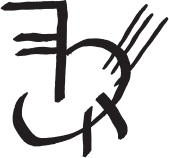Icelandic Magic (10 page)

GALDRASTAFIR
Many galdor staves begin as runic symbols that make up words or names in Old Norse. Sometimes these runes are themselves stylized to conceal their identity from even those versed in rune lore. At other times they are combined into so-called bindrunes or runic monograms, which are often then further stylized according to aesthetic and magical intent. Concealing the runes and their outer meaning from the conscious mind seems to have been a prime motive of the ancient practitioners of galdor-stave magic.
Of course, everything that has been said thus far about traditional signs leads the practitioner to knowledge of how to construct new signs with the correct magical meaning for given operations.
In my 1992 book,
Northern Magic,
written under the name Edred Thorsson, I first discussed the semiotics of
galdrastafir.
The specifics of the lines making up the signs constitute the metaphysical “words” in this magical language, while certain symbolic matrices make up its hidden “grammar.” It could therefore be said that the kinds of magical signs shown in the Gray-Skin section of this book provide a geometry of the will. Others have remarked that the galdor signs appear to be akin to the “circuit boards of consciousness.” Altering the circuits causes alterations to occur in the mind and/or in the universe of events.
Magical signs were first uncovered by ancient magicians using a method of trial and error. When they hit upon signs that worked for them, they recorded them in their books and made notes about their effectiveness. Such effective signs were then used by subsequent generations, and they became traditional. There is no reason why current galdor practitioners cannot do the same thing. However, for the sake of your own rate of success it is recommended that you stick with some traditional signs for the beginning phases of your work. You have to get through the beginning before you can reach the middle and go beyond.
When converted to magical signs, the names of Ãðinn shown in appendix C can be used for a wide variety of operative aims. The interpretations of these names suggest a wide range of such aims: if one wants inspiration, use Ãðinn; if one wants success in business, use Farmatýr; if one wants a wish fulfilled, use Ãski; and so on. In chapter 4, I showed how names of Ãðinn were used in history for exactly this purpose and in exactly this way. This form of magic is very ancient and obviously long in use in Iceland before it was atavistically “rediscovered” by modern magicians such as Austin Osman Spare.
How are these names to be transformed into magical signs? Here there is a science and there is an art. The science indicates that there is a definite mode of transliterating the names into runes of the Younger FutþÄ
rk. To do this, follow the rules provided in appendix A of this book. The process of learning how to do the transliterations is actually a dimension of magical preparation. If someone else was to do it for you, the magic would not be as effective.
The names of Ãðinn in runic form already constitute a magical avenue for the activation of the power of the name for operative purposes. These names in runic form can have the indicated effect and can be written, carved, or scratched in ritual format to effect the operation.
However, for the greatest potency, to “key” the working at the deepest levels, these runic formulas should be converted into
galdrastafir.
This is where the artistic aspect comes in. The names should be converted to runes according to certain rules as indicated, but they are combined into bindrune-based magical signs according to the aesthetic sense of the magician. The aim of the operation also plays a part: if the operation seeks harmony and goodwill, symmetry and grace may be your guiding principle, but if destruction or chaos is your aim, then perhaps the resulting magical sign should reflect this spirit.
Besides names of Ãðinn, Old Norse words that express a specific magical aim can be transliterated into runes and combined into bindrunes in the same fashion to similar effect. For example, if someone wants peaceful relations with others, the Icelandic word
friður
(or its earlier Old Norse form,
friðr
), meaning “peace,” could be transliterated according to the rules in appendix A, rendering . Then this word is turned into a bindrune and stylized as shown in figure 9.7.
. Then this word is turned into a bindrune and stylized as shown in figure 9.7.

Fig. 9.7. Galdor stave based on the Old Norse word
friðr
Â
Â
PART TWO
Gray-Skin
Â

INTRODUCTION TO THE WORKINGS
What follows is the Gray-Skin proper. The first part of this book was an introduction to the history, theory, and practical principles of Icelandic galdor-stave magic. The second part is a unique book of magic in the traditional Icelandic form. This whole book is not part of a program of any specific magical order or school, although it is a product of work done in the Rune-Gild from about 1981 to the present. The work really belongs to anyone who grasps its principles and makes the grammar of the metalanguage work for himself or herself. This form of magic is very close to pure art, and there will be those with greater or lesser degrees of talent in this art. The author is interested in hearing from successful practitioners of the system. Most of my own success with the system has come from using it in moments of dire need, and for the sake of discovering unknown, yet traditional, aspects of the system itself. It should be noted that the texts in what follows are sometimes not literal translations of the original Icelandic texts but have been adapted for current use and effectiveness. Literal translations can be found in the various scholarly books included in the bibliography.
The practical section of this book, chapter 9, gives detailed instructions on how to work with these signs and formulas. As a general rule the content of the workings below is inserted in the operative part of the ritual format outlined in chapter 9. The texts below show the working-specific data to be employed for certain definite aims. Occasionally the instructions call for actions to be performed “in the field” and not in your ritual space. These workings are for the most part historical or traditional examples of galdor-stave magic. This is the best way to learn. They are intended as training for more original work once the grammar of the system is to some extent mastered. The current galdor man or galdor woman is as free now as the Icelandic magicians of old were to create original signs and staves based on the principles outlined in chapter 9 of this book. Those workings will probably be found to be even more effective than the historical examples. Remember that this form of magic was first and foremost pragmatic, and to be true to its spirit the current practitioner should be innovative rather than hidebound with respect to the tradition.
Pages have been intentionally left blank at the
end of the book
for you to inscribe your most successful workings in the traditional fashion. This will make the book truly your own.
In general the following workings have been grouped according to theme and type. The higher and more spiritual kinds of workings come first, followed by more basic motivations. The pragmatic world of Icelandic galdor-stave magic takes all aspects of human life into account. The needs of humanity are many and the gods of Heaven, Hell, and Valhöll are all brought to bear.
Although this book is not intended as a scholarly tome, readers today are often curious about the origins and sources of things. For this reason each of the workings below has been referenced to the original Icelandic manuscript or edited and published work from which it came. Some workings have been adapted or modified for current usage, and there are a few that have been recorded in this book for the first time. Each of the newer workings has been tested and has been shown to be effective.
I. WISDOM
These workings lead the practitioner to insight, greater knowledge, discovery of the unknown, and generally open the soul to the workings of wisdom.
1
  Â
Â
T
O
A
WAKEN
Y
OURSELF
TO A
S
ENSE OF
M
YSTERY AND
W
ONDER
Draw this sign with white or silver ink on black paper at midnight on the Spring Equinox. Hide the sign in a wooden box. This spell works over a lifetime.

2
  Â
Â
F
OR
I
NSIGHT INTO
T
HINGS
BEYOND THE
E
ARTHLY
R
EALM
Write this stave with red ink on white paper. Put it in a wooden box or carry it with you in your left breast pocket, and insight into heavenly things will come to you.

3
  Â
Â
T
O
L
INK
Y
OURSELF
WITH THE
P
OWER AND
K
NOWLEDGE OF
Y
OUR
S
OUL
To bind yourself fast to the power of your own soul, draw these staves on parchment and keep them with you always.

4
  Â
Â
T
O
K
NOW THE
U
NKNOWN
To be able to understand and analyze hidden things and patterns of manifestation, draw this stave and keep it in your room in a secret location.

5
  Â
Â
D
ISCOVERING THE
U
NKNOWN
(L
BS
2413 8
VO
100)
If you desire to know what is concealed from the common folk, carve these staves on brass with a steel instrument and put it near your ear and sleep and you will experience [
reyna
] it.

6
  Â
Â
C
ONCEALMENT
(L
BS
2413 8
VO
73)
If you want to hide something so it will not be found, carve this stave with your eating knife and the object in question will not be found; read the Paternoster.

7
  Â
Â
F
OR
G
AINING
I
NSPIRATION
